|
|
The
Great Migration
During the first 25 years of the 19th century, dozens of Mennonite families from
eastern Pennsylvania uprooted their lives and migrated to what became the
Waterloo area of eastern Ontario. Among them were families who turned out to be
our ancestors because they married into the family of Abraham Stauffer (1748-1823), our
primary Stauffer ancestor. Most all of them were neighbors and friends of our
ancestors.
WHY THEY WENT
Two primary reasons caused so many of the Mennonite community to make such a
tremendous move. One had to do with their convictions, and one
had to do with the practicalities of their lives. Which reason was more
important with each individual family undoubtedly varied.
The issue of convictions related to their faith. Because they did not believe in
taking up arms and fighting, they had not supported the American Revolution in the 1770s.
There was also the fact that England had granted them refuge and homes in its new-world colonies,
so they felt an abiding loyalty to it. However, the Waterloo area did not open up
for settlement until the turn of the century a couple of decades after the
Revolution, so for some time the Pennsylvanian Mennonites
bided their time and watched for new options.
 Because they were primarily agricultural people, the unsettled wilderness lands of
Pennsylvania had initially been most welcome to them. However, as the 18th century drew to
a close and the colonies grew in population, the land began to fill up. The
Mennonite farmers began to feel "crowded." When they learned about new lands opening up
in Canada, lands that were still virgin forest, many needed little
encouragement to be a part of it. Male family
members, including single ones, made a trip to check it out. Those who had families
wasted little time in coming back for them.
Because they were primarily agricultural people, the unsettled wilderness lands of
Pennsylvania had initially been most welcome to them. However, as the 18th century drew to
a close and the colonies grew in population, the land began to fill up. The
Mennonite farmers began to feel "crowded." When they learned about new lands opening up
in Canada, lands that were still virgin forest, many needed little
encouragement to be a part of it. Male family
members, including single ones, made a trip to check it out. Those who had families
wasted little time in coming back for them.
A migration such as this was not a simple thing. When I wrote "Portrait of Elizabeth," I
had to apply my imagination to what the trips would have been like from
Pennsylvania to Canada and what the families who went would have found there.
Now that Ezra Eby's materials are on the Internet, I find that my imagination
was not far off. Eby provides pages full of vivid descriptions of what
those early pioneers experienced.
Waterloo County, Ontario, is about 75 miles northwest of Niagara Falls. It and a large area around it was "granted" by the British to
the Indian leader Joseph Brant and his people for their help against the
colonists in the Revolution. Brant contracted to sell 94,000 acres to a Richard
Beasley and two partners. At the turn of that century, two Englishmen were
commissioned to clear a road (Eby uses the word "slash") between
Niagara and the Grand River in the area that became Waterloo. The two men liked what
they found and made plans to move their own families there.
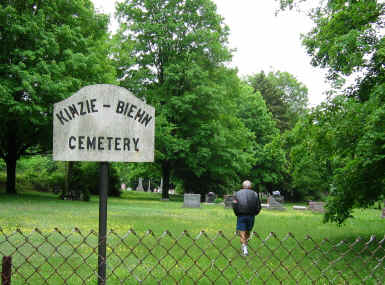 |
|
... where Daniel and
Susannah Stauffer are buried and possibly his older brother
Abraham and wife Catherine |
In 1801 and 1802 several families went from Pennsylvania and settled in Waterloo
Township. They bore a number of names that turn up in our Stauffer records
because in time they married Stauffers. These include Kinzie, Gingerich,
Rosenberger,
Biehn (eventually spelled Bean), Clemens, and Shupe. All bought land from Richard Beasley.
PROBLEM WITH LAND SALES
In January 1803, a cloud appeared on their horizon. They discovered that
Beasley did not have a clear title to the land he had sold since two other men
owned it as well. Those already in Canada were alarmed about the legitimacy of
their claims, and those in Pennsylvania halted plans to go there. Beasley
could sell no more land, so he proposed to the settlers that they form a company
to buy the whole tract. Samuel Bricker and Joseph Sherk were dispatched to
Pennsylvania--to relatives of those already in Canada and those planning to come--to raise the $20,000 needed to close such a deal.
The men were unsuccessful in the first two counties they visited--Franklin and
Cumberland. Sherk in discouragement returned to Canada, but Bricker went on to
Lancaster County. There a meeting was arranged in the home of John Eby (known as
"Old Hannes Eby"). At first that audience too was unresponsive, but
finally old Hannes spoke up and approached it from a different perspective.
Instead of looking on it as a business proposition for making money, he
suggested they look on it as a responsibility from God and their duty to
help their "Canadian brethren" who were in a stressful bind.
That generated a response, and in April 1804 a company was formed and shares
of the land were all promptly sold. The next challenge was to get the money to
Canada. Daniel Erb was appointed to assist Bricker in the task. They both
declined payment for their services. Twenty thousand
silver dollars were put into a strong box and entrusted to them to see
safely to Canada. The "buggy" on which the box of money was
transported stood for many years on the “old Bricker farm" near Chicopee.
It's a shame it was not preserved for future generations to appreciate.
Following necessary legal steps and eventually the delivery of the money to
Richard Beasley and his wife, 60,000 acres of purchased land were surveyed and divided
into numbered lots of 448 acres each.
Our Stauffer booklet titled, "History of the Stauffer Families Who Came to
Ontario," tells us
Abraham Stauffer made a surveying trip to Canada with his friend John Erb, and
it is interesting to learn how many families did that. However, it isn't
completely clear exactly how the Stauffer account fits with what Eby tells us. The booklet does not mention the purchase
of land from Beasley. It just says:
"Around 1803-4 Abraham joined
John Erb and party to come to see the Waterloo Township area which was
attracting the attention of many of his Pennsylvania-German Mennonite relatives
and neighbors."
We also have some confusion about when our Stauffers made the move. Eby says the
Erb and Stauffer families came to Waterloo in the spring of 1805.
Finding those names together in such a source and with the 1805 date is exciting
because it confirms what the Stauffer booklet tells
us. However, the booklet says that "in August 1805 Abraham sold his property...to his
brother-in-law Abraham Zug," and other records tell that the sale of the property happened on
August 17, 1805. Whichever season it was, it seems likely that the Stauffers
made the journey and arrived in Canada before the winter of 1805 set in.
A TRIP TO REMEMBER
Eby tells us that the trips moving to Canada were made by covered wagons, pulled
mostly by horses. Some had supplementary tents because they had to spend many
nights in the open. Some groups had cows as well as horses, and that supplied
them with welcome milk and butter on the journey. Not much is said about what
else they ate on those journeys, but we can imagine staples had been brought from
home, and they probably ate a lot of game. It is hard for us today to
imagine "camping" in the rough every night, hiking many miles every
day--for weeks on end and with no McDonalds
or Krogers along the way.
In some places, those earliest to make the trip actually had to cut through the
forests to widen the trail. All of them faced two major hurdles--first the Allegheny
Mountains, and then, on the Canadian side of the Niagara River, the Beverly
Swamp. Eby tells us that some of the early trips took as much as ten weeks. The condition of the roads apparently improved with time because later
journeys are reported to have taken four or five weeks.
Eby gives vivid accounts of some of those travel challenges, learned directly,
I'm sure, from descendants of those involved. Many
of the first generation born in Canada
were still alive when Eby did his research at the end of that century, so he
could get almost firsthand information.
Several large rivers had
to be crossed, including the Susquehanna, the Tonawanda, and the Niagara.
Sometimes the water reached the beds of their wagons and got their possessions
wet. Sometimes they had to cut down trees on both sides of a river to build
"some kind of a passageway" (Eby's words) for the crossing. One river
had steep banks, a challenge for maneuvering horse-drawn wagons. Occasionally the
huge wagons would overturn, with serious damage to the
contents. Such specific
stories undoubtedly happened to other parties as well.
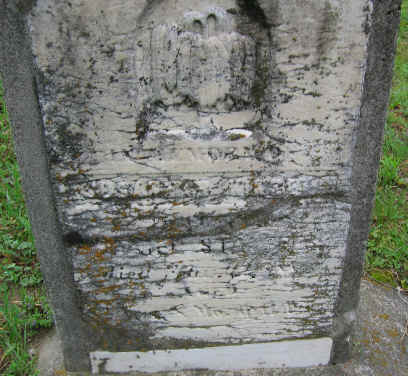 |
|
Susannah's headstone, in the Kinsey-Beihn Cemetery, is
almost unreadable, but it says: In
Memory of Susannah Kinzie, wife of Daniel Stauffer. Died
Feb. 11, 1881. Susannah lived 35 years after
Daniel died at age 50.
|
Eby gives a detailed account of one of the earliest groups (1802), which
included seven families from Montgomery County in Pennsylvania. The families had fifteen
children and four grown children, as well as several single men. One of those
children was four-year-old Susannah Kinzie. Susannah would grow up to marry Daniel
Stauffer, son of Abraham and Elizabeth, who
three years later at age nine would come to Canada with his family. George Clemens made the trip with this group--George who married
Daniel's sister Esther and fathered eighteen children [Esther
Clemens
story]. John and Elizabeth Diefenbach Shupe and their teenage son George
were in that group. Forty years later, George's daughter Magdalena would tie
those
lines to the Stauffers when she took on five young step-children. Soon after,
she become the mother of our
Samuel Stauffer who died in the well.
For that group, that early Allegheny crossing was especially difficult. We are told
they often had to unload many of their possessions before the horses could pull
the wagons up the mountains. Sometimes they had to pay others (it doesn't say who) to transport the
belongings to the top of the mountain because their own teams simply could not handle it
all. I wonder if stories like this reached the ears of the Stauffers while they
were still in Pennsylvania and, if so, what kind of plans and preparations it prompted them to
make as they got ready for their own journey.
When this group reached the Beverly Swamp, they were delayed for two weeks while
their men worked to make the road through the swamp passable for their horses.
When they finally made the crossing, George Clemens drove the first team across
the swamp. It would be interesting to know which of his three children who were still
alive in Eby's day told him about that.
In 1804 Michael Groh of Montgomery County, Pennsylvania, made
the trip to Canada to check out what he had heard. He liked what he found so well that he
bought six acres, cleared land for winter wheat, built a small cabin, and headed
back home for his family. Within a month the
rest were on their way to Canada. After they crossed the Niagara River, Michael became ill.
One daughter stayed with him while the rest of the
family pressed on. By the time they arrived, word reached them that Michael had
died. Two years later daughter Esther would marry Abraham Stauffer's son Samuel, who was yet to come
with that family from Lancaster County.
Eby tells us that the 1805 group with the Stauffers and the Erbs made the trip
in five weeks. They crossed the Niagara River using a "scow"--a
flat-bottomed boat with square ends about 12-14 feet wide and 30 feet long. The
scow was propelled by oars. Had someone figured out that a good way to make
money was to provide crossing of that large river, not just for local traffic
but for those groups that continued for more than twenty years to pour in from
Pennsylvania?
According to Eby, the struggles of a group in 1806
required nine hours to climb the three miles to the top of the Allegheny
Mountains. That may have been typical for most of the groups. Six horses had to be hitched to each wagon in turn, and they could
only cover ten or twelve "rods" (half the length of a football
field) before horses and men had to stop and rest. (Apparently by
then they had learned that having enough horses prevented them from having to
pay others to transport their things up the mountains.)
NEW LIFE IN CANADA
What these groups found when they reached the Waterloo area was rich,
virgin forest. The first thing they had to do was scout the land and decide
which portion they wanted to claim. There was plenty of lumber to build their
homes, but doing so had to have been an incredible amount of work At
first all work with the lumber had to be done by hand.
Some of the homes were quite nice and even had two stories. The Christian
Schneider house, built in 1807 is open to visitors today.
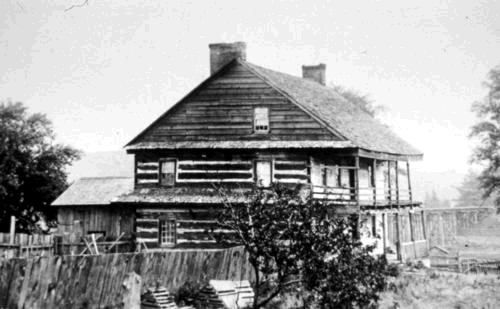 |
|
Christian
Schneider house built c.1807 near Doon.
This photo dates from 1895.
Photo
courtesy of http://ebybook.region.waterloo.on.ca/
|
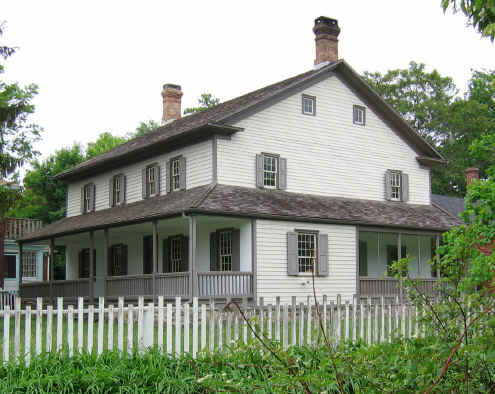 |
|
The Schneider House
today |
The life for the earliest of the pioneer settlers was full of challenges. We are told that at one point they had to save the peelings
from their potatoes in order to have something to plant the following spring. At
first, of course, there were no stores, schools, or community services, but it
didn't take long for those to begin to appear.
Waterloo County is on the banks of the
Grand River, so they had ample water and plenty of fish. Before long, smaller streams in the area, on their way to the Grand, were
providing waterpower for mills. Remember Abraham Stauffer's friend John Erb? He settled on the Speed River and in 1806 erected his saw mill.
For the first time, the settlers could get sawed lumber closer than Toronto or Niagara. A year
after that, John erected a grist mill for the grinding of grain. One by
one new families added services to the community.
Abraham Stauffer and his family settled "where the Blair bridge now
is" ("now" being the early 1890s). Eby gives the locations for
all the major families, but most of them are tied to whoever owned them at the
time he was writing, and such descriptions don't mean much to us now. The Stauffer
booklet tells us
Abraham bought 100 acres of land in March 1806 and in 1811 another
95 acres. We don't know what the family did for that winter of '05-'06. When
Abraham died twenty years later, he left his land to his son Daniel, and decades
later his grandson Noah hosted the centennial celebration of their family's migration on
that piece of land (see below).
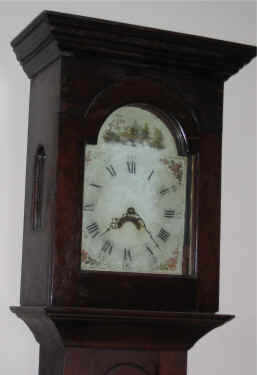 |
|
This clock made the original trip from
Pennsylvania.
|
Though the rich world around them provided good sustenance, it was
also capable of dealing trauma and loss. In May 1806 two terrible fires swept
through the forest and some of the settlements. The first one started when a settler
was clearing the land in preparation to plant and needed to burn the brush.
After the fire was going, a strong wind came up, and soon those who set it had
to stand by, frantic and helpless, as the fire accelerated beyond the area they wanted to burn. It roared its way along, destroying timber, fences, houses,
and barns. Abraham Stauffer lost his barn to the fire. If he bought his land in
March and this was May, the barn must have been brand new! Eby doesn't mention livestock, but much valuable timber
was lost. A second fire soon after destroyed more timber but spread to the east where there
were no settlements.
A REUNION TO COMMEMORATE A BRAVE GROUP OF PEOPLE
In August 1904, the Stauffer clans decided to hold a centennial celebration in
honor of their predecessors who had made their way to Canada. It took place
at the home of Rev. Noah Stauffer, Abraham's grandson. If we understand
correctly, it was held on the very property that Abraham himself laid claim to
when he came from Pennsylvania, property which he had willed to Daniel and which
ended up with Daniel's son Noah. Notice that Noah and his wife died just two
days apart.
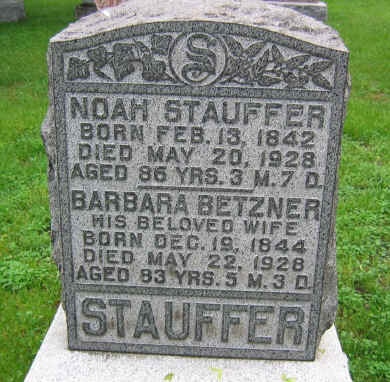 In this day when reunions
are sometimes planned a year or more in advance, it is interesting to know that in two
months time, without e-mail or perhaps few telephones, that 1904 reunion gathered 600 people from five states, "almost every
town and city in Ontario" and a few from the Canadian West. An appointed committee made all the preparations
and did all the work. It would have been a challenge to sleep all those people
as well as feed them.
In this day when reunions
are sometimes planned a year or more in advance, it is interesting to know that in two
months time, without e-mail or perhaps few telephones, that 1904 reunion gathered 600 people from five states, "almost every
town and city in Ontario" and a few from the Canadian West. An appointed committee made all the preparations
and did all the work. It would have been a challenge to sleep all those people
as well as feed them.
The Stauffer booklet gives us the description, quoted from a newspaper
article.
"From nine o'clock in the morning until after noon the guests began to arrive.
The stable room was soon overtaxed, and ere long every stable in the vicinity was
filled. To feed so great a gathering of people was an enormous task. The
committee bought all the supplies necessary and brought them to the homestead.
None of the guests brought any eatables. The good things were prepared by Mrs.
Stauffer [Noah's wife] and her assistants, and the dinner was served on the
threshing floor of the big barn. The sides of the mow were covered with
evergreens, and a big welcome banner greeted the diners as they stepped across
the threshold. The two long tables seated about 135 persons at a time."
CONCLUSION
Ezra Eby is a worthy spokesman for the early Waterloo settlers and the life and
world they created for themselves in Canada. He begins by recounting the
sufferings and persecutions from which they fled in Europe. They arrived in the new
world poor to the point of destitution, but "in the midst of all
their trials and sufferings they prospered." He speaks highly of their work
ethic, the fine homes they built, and farms they established.
Nearly a century
later, many descendants were living on the inherited land to which a father or
grandfather had staked his claim. At least in the 1960s, the Stauffers at were
still holding reunions in the
Waterloo
area. If
anyone reading this knows if those reunions are still held, I would love to hear
about it. See "E-mail me" on the home page of this website.
|
